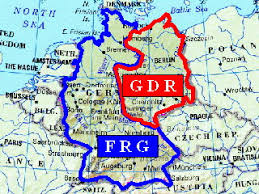By Jess Bank
Germany: A Country Divided
Germany is a fascinating country to study educationally and historically, because there really were two distinct systems in place after World War II until 1989 when the wall is considered to have officially fallen. After World War II, Germany either identified with the Allied Forces (West Germany) or followed more communist ideals (East Germany). Therefore, the wall truly was a tangible thing to keep the two views separate.

http://berlinwall.soaringdevelopment.com/divisions.aspx
The FRG, or Federal Republic of Germany, was the governmental system declared by West Germany and believed in a capitalist society. The former GDR (the German Democratic Republic) identified with communism. Kubow and Fossum (2007) stated that in many respects, the GDR’s system of education was more coherent than in the west because, under the FRG plan, there were (and still are in present-day Germany) three overseers to education: local government, The Lander (state government), and the federal government all act as overseers to the educational system. However, in East Germany, there was one overseeing body, which streamlined the education process and helped the educational system be much more cohesive.
Education in West Germany
Education reform and changes often happen from the Lander and then travels up to the federal level. This structure, said Stevenson and Nerison-Low (1999), meant that educational standards handed down from the federal government were often seen as merely suggestions (rpt. in Kubow and Fossum, 2007).
In an effort to create educational equality, the FRG drafted a temporary constitution which held that every citizen could choose his/her education to lead to a desired profession–this was a right according to the Greundgesetz. The FRG’s commitment to equality in education is also demonstrated through compulsory education requirements. While kindergarten is not mandatory, education begins for students at age six. At age ten, students are sorted into three educational groups, and advance to a different school for the next 9-10 years. These three schools (which will be discussed later ) determine which higher education students will pursue, if at all. One distinct advantage to this system, in theory anyway, is the idea that students can travel between schools; in other words, “move up or down the ladder (Perry, 1991 rpt. in Kubow and Fossum, 2007).
Education in East Germany
East Germany, headed by the GDR, approached education with a completely different philosophy. First, the goal of education in East Germany differed greatly from the FRG’s view, due to the simple fact that the governments were so different from each other. The purpose of schooling in East Germany had three overarching objectives: first, guarantee the economic development of its society; second, establish a classless society; and finally, ensure the views of communism were not threatened.
In addition to differing political views about education, the former GDR’s educational structure was different as well. Students would begin compulsory education at age six and attend school for ten years. After the ten-year period, some students would continue with an additional two years of schooling that was not compulsive. The school system followed what is called the polytechnical model, which was not specifically focused on any one area of study, but was meant to prepare students with practical knowledge and skills, including pre-military training. By the time students reached the seventh grade, approximately 1/3 of all curriculum was devoted to math and science.
The wall falls: A merging of two educational systems
Once the Berlin Wall fell, Germany was left to create an educational system that served the needs of both East and West citizens. What ended up happening was the the system the FDR had in place ended up being the educational system used nation-wide. One of the reasons for the overall adoption of the FRG system could be the call for change from East Germans prior to the falling of the wall. A chart below illustrates how the educational system today works:

http://www.socsci.uci.edu/~rdalton/germany/ch5/chap5.htm
Grundschule, the equivalent of the United States’ elementary school, is the first stage of compulsory education. At age ten, students are sorted and it is determined whether they attend Hauptschule, Realschule, or the Gymnasium. Many critics say that sorting students in the fourth grade is far too early to determine whether a students will be attending a university or not. The Hauptschule is basically an easy way to finish out mandatory education. The Realschule is sort of a middle ground between Hauptschule and the Gymnasium, which is the university track.
The criticism of early sorting is not the only negative thing that can be said about Germany’s education system. In a recent study, researchers found that immigrants do not perform as well in class as native-born Germans do (Spiegel, 2006). This creates a class disparity because immigrants who are not performing well in the fourth grade are placed into compulsory education that does not lead to the university. However, as Antonio (2005) points out, there is high interest in vocational tracks, and so students may prefer to enter Hauptschule or Realschule.
Some implications of the merging to the FRG system was the displacement and different roles of teachers. After Reunification, an estimated 29,000 teachers lost their jobs (Kubow and Fossum, 2007). Additionally, teachers were displaced because certain subjects were considered “susceptible to ideological contamination (pg. 198).” However, the FRG did attempt to aid the displaced teachers in some ways, like teaching Russian teachers (the language of instruction in East Germany) how to teach English.
